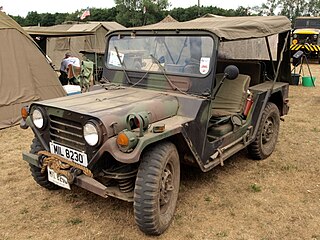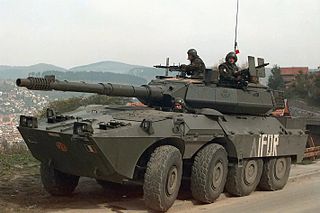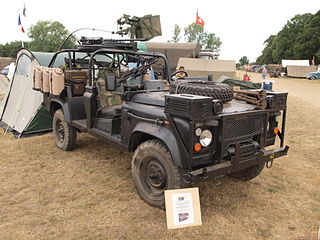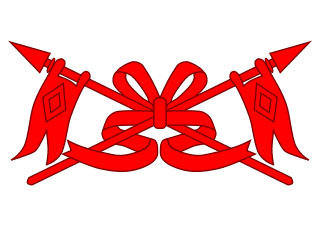The Brazilian Navy is the naval service branch of the Brazilian Armed Forces, responsible for conducting naval operations.

The Brazilian Air Force is the air branch of the Brazilian Armed Forces and one of the three national uniformed services. The FAB was formed when the Army and Navy air branches were merged into a single military force initially called "National Air Forces" in 1941. Both air branches transferred their equipments, installations and personnel to the new force.

The Desert Patrol Vehicle (DPV), formerly called the Fast Attack Vehicle (FAV), is a high-speed, lightly armored sandrail-like vehicle first used in combat during the Gulf War in 1991. Due to their dash speed and off-road mobility, the DPVs were used extensively during Operation Desert Storm. The first U.S. forces to enter Kuwait City were United States Navy SEALs in DPVs.

The Truck, Utility, ¼-Ton, 4×4, M151 or simply M151 was the successor to the Korean War M38 and M38A1 jeep Light Utility Vehicles. The M151 had an integrated body design which offered a little more space than prior jeeps, and featured all-around independent suspension with coil springs. It has since been replaced by the larger AM General HMMWV in most utility roles in frontline use. With some M151A2 units still in U.S. military service in 1999, the M151 series achieved a longer run of service than that of the World War II/Korean War-era MB/GPW, M38, and M38A1 series combined.

The Centauro is a family of Italian military vehicles originating from a wheeled tank destroyer for light to medium territorial defense and tactical reconnaissance. It was developed by a consortium of manufacturers, the Società Consortile Iveco Fiat - OTO Melara (CIO). Iveco Fiat was tasked with developing the hull and propulsion systems while Oto Melara was responsible for developing the turrets and weapon systems.

The Pandur II is an improved modular all-wheel-drive version of the Pandur 6x6 APC wheeled armoured vehicle. It was developed as a private venture by the Austrian company Steyr-Daimler-Puch Spezialfahrzeuge. Steyr-Daimler-Puch Spezialfahrzeuge is part of General Dynamics European Land Systens (GDELS), which is also the parent company of MOWAG of Switzerland and Santa Bárbara Sistemas of Spain.

The Brazilian Marine Corps, is the land combat branch of the Brazilian Navy. The Corps is specialised in amphibious warfare.

The Sherpa Light is a family of 4x4 tactical and light armored vehicles developed by French company Renault Trucks Defense (RTD). Available in unarmoured or armoured variants, the Scout is suited for tactical missions such as scouting, patrol, convoy escort and command and liaison. It is able to transport up to 4 or 5 soldiers or a total payload of up to 4 tonnes.

The Light Strike Vehicle (LSV) is an improved version of the Desert Patrol Vehicle (DPV) it replaced. Although the conventional US military replaced its DPVs with Humvees, special operation groups adopted the LSV for its small size and high mobility. It is part of the family of Internally Transportable Light Strike Vehicles (ITV-LSV). It is used for fast hit-and-run style raids, scouting missions, special forces support, and low intensity guerrilla warfare.

The Ranger Special Operations Vehicle (RSOV) is a light military vehicle of the U.S. Army's 75th Ranger Regiment, based on the Land Rover Defender. The RSOV is not meant to be an assault vehicle, but rather a rapid defensive platform.

The T-98 Kombat is a wheeled armoured vehicle built by Kombat Armouring, a subsidiary of Laura Group, in Saint Petersburg, Russia. The name, is shorthand for "komandir batalyona". The Kombat is a fast armoured off-road vehicle with a top speed of 180 km/h.
The Light Strike Vehicle (LSV) is a light fast attack vehicle used by the Singapore Army. In 2013, the Singapore designed and made Light Strike Vehicle Mark II entered service to replace the ageing Singapore and Australian made Light Strike Vehicle in service since 1998.

The Chenowth Advanced Light Strike Vehicle (ALSV) is an all-terrain light military vehicle developed by the United States. It is the successor to the Chenowth Light Strike Vehicle and the Desert Patrol Vehicle, and features improved performance and armament. The sandrail vehicle is relatively small, and can be carried in a transport aircraft. Although it is mainly used by the US Navy SEALs and Marine Corps, several other countries have procured it.

The Marruá is a family of four-by-four wheeled transport and utility vehicles, built by Agrale in Caxias do Sul, Rio Grande do Sul, Brazil. Developed in the early 2000s to serve as a replacement for ageing jeeps and other vehicles in Brazilian service, it has also been adopted by several other South American armies, and is used on peacekeeping missions with the United Nations in Haiti.

The VLEGA (an acronym for "Vehículo Liviano de Empleo General Aerotransportable" Gaucho was a prototype of a military light utility 4x4 vehicle, capable of being transported by air. It was developed by Argentina and Brazil in the 2000s for employment by their militaries. Some of its uses included: cargo/transport, reconnaissance, ambulance, special operations.

The Long Range Patrol Vehicle (LRPV) is a 6x6 patrol vehicle that was used by the Australian Special Air Service Regiment (SASR) in Afghanistan and Iraq.
The Flyer Advanced Light Strike Vehicle platform has been developed by General Dynamics Ordnance and Tactical Systems (GD-OTS), in partnership with Flyer Defense LLC, for the U.S. Special Operations Command (SOCOM) Ground Mobility Vehicle Program. The Flyer Advanced Light Strike Vehicle platform configurations are the Flyer 72 and the narrower Flyer 60.

P6 ATAV is an Indonesian Light Attack Vehicle, manufactured by PT Sentra Surya Ekayaja. It made first public appearance in Indo Defence 2016. It is classified as rantis by Indonesian military.
The Brazilian Army has a large number of active and planned projects, under the modernization plans of the Brazilian Armed Forces, defined in the National Defense White Paper. From 2010, Brazil started a radical change in its military policy, aiming to consolidate itself as the major power of Latin America.

The Brazilian cavalry is one of the branches that make up the Brazilian Army. It operates in armored vehicles and, like the infantry, has the role of directly confronting the enemy, but with distinct missions such as reconnaissance and vanguard. It is organized into regiments and squadrons, which are equivalent to the infantry's battalions and companies. Its main types are tank, mechanized, armored and guard. Its troops serve in vehicle crews or as fusiliers on board, who can also fight on foot.















